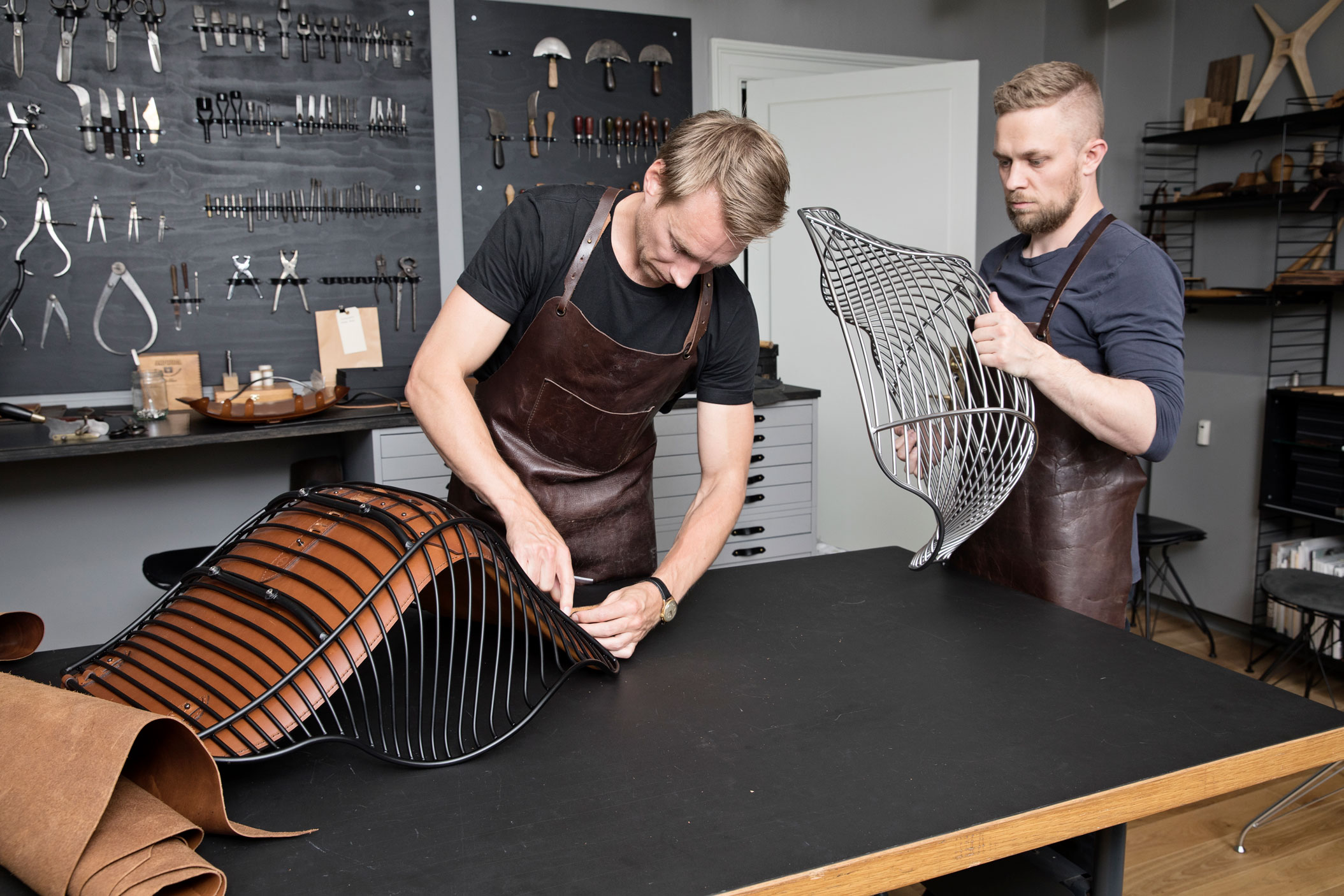These designers quit their jobs to craft the perfect chair
- Text by Michael Fordham
- Photography by Esben Salling
“We often find inspiration in biological mechanisms in the ocean and on land — the structure and the connections and the overall shape,“ says Jasper Overgaard.
Jasper is one half of the Danish furniture builders Overgaard & Dyrman, who have built a worldwide reputation for combining the rustic and the urban aspects of Denmark’s design tradition.
They have produced some of the most original, most immaculately rendered furniture to come out of the Nordic nation in recent years.

“We are of course inspired by some of the most famous craftsmen and architects that have created the Danish way of design,” he says, “especially people like Finn Juhl and Poul Kjærholm — but for us it is more about our own little experiment.”
As well as the aesthetic of totemic individuals around which much of the design culture has revolved — you can see the influence of the superbly detailed drawing of evolutionary biologist Ernst Haeckel in the fruits of Jasper’s labour.
The work’s organic intricacy, often combining apparently complex patterns of metalwork interwoven with tactile elements in leather, is underpinned by a logical simplicity, one that reflects the naturally evolved complexities of biological forms.

“It’s easy to make the argument that the world doesn’t need another chair,” he says. “Therefore our products are not necessarily simply fulfilling a need — they come from a passion for purity. We want our products to become objects of conversation as much as a simple place to sit.”
Jasper is based in his central Copenhagen studio. There’s a quietly intense atmosphere. An array of immaculately rendered tools on the walls. There are beautiful steel rendered awls and groovers, racers and punches, skivers and bevelers spotlit by Denmark’s signature slanting light.
“Our aim is that our process has integrity from start to finish,” he says. “We love it when a piece of furniture is beautiful from the time you make the first sketch to the end of its lifetime.”

Each stage of the Overgaard & Dyrman process is shot through with integrity of purpose. “The tools we use are as important in term of design as the furniture itself,” he says.
“I found these incredible leather working implements. They are truly beautiful objects made to immaculate standards. It turns out the tool maker is a blind man — an absolute perfectionist in what he does. We believe that if the process of tool making itself is so precise that the things these tools make will naturally be better, more exact.”
You can’t help but notice the unhurried intensity with which Jasper works. There’s a tangible mindfulness about everything he does.
“I love working with leather because when you interact with it you become aware that it is a fundamentally natural material, and like all natural materials it can be very malleable and soft in one direction, but incredibly tough in another. It’s a wonderful challenge.”

Jasper’s design partner Christian Dyrman lives and creates the metalwork elements of the Overgaard & Dyrman design in a studio in Northern Jutland — the pair coming together to research, plan and finish the products every second week or so. There’s something fundamentally and pragmatically Danish in the arrangement.
“Christian and I have known each other since we were students, and worked closely together for so many years before we finally both quit our jobs and started the company,” he says.

“This gave us a solid base upon which to build. We have been able to bring our different characters and expertise to what we do, and they complement each other. We didn’t start from a business plan,” he says.
“We simply made furniture that we loved and then people started ordering it. The business was born of simple passion for design.”
Read more about Jasper making things #TheDanishWay
Enjoyed this article? Like Huck on Facebook or follow us on Twitter.
Latest on Huck

Bernie Sanders introduces Clairo at Coachella, urging young Americans to “stand up for justice”
Coachella charmed — The Vermont Senator praised the singer-songwriter for her efforts in raising awareness of women’s rights issues and Gaza.
Written by: Isaac Muk

The Changing Face Of Brooklyn, New York’s Most Colourful Borough
After three decades spent capturing stories around the world, Magnum Photographer Alex Webb finally decided to return home to Brooklyn – a place that champions chaos, diversity and community spirit.
Written by: Alex Webb / Magnum Photos

The mundane bliss of New York’s subways in the ’70s
NYC Passengers 1976-1981 — During a very different decade in NYC, which bounced between rich creativity and sketchiness, photographer Joni Sternbach captured the idiosyncratic isolation found on its rail networks.
Written by: Miss Rosen

Analogue Appreciation: lullahush
Ithaca — In an ever more digital, online world, we ask our favourite artists about their most cherished pieces of physical culture. Today, it’s Irish retro-futurist lullahush.
Written by: lullahush

Spyros Rennt captures connection and tenderness among Berlin’s queer youth
Intertwined — In the Greek photographer’s fourth photobook, he lays out spreads of togetherness among his friends and the German capital’s LGBTQ+ party scene.
Written by: Isaac Muk

The rebellious roots of Cornwall’s surfing scene
100 years of waveriding — Despite past attempts to ban the sport from beaches, surfers have remained as integral, conservationist presences in England’s southwestern tip. A new exhibition in Falmouth traces its long history in the area.
Written by: Ella Glossop